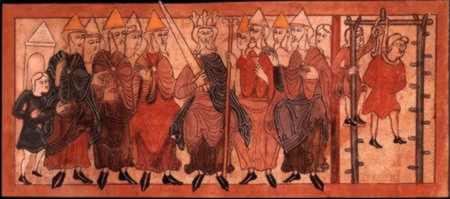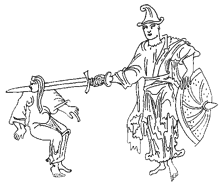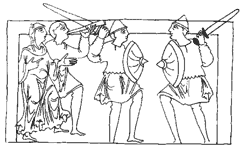 |
The English tribes who came over from the Continent already possessed an elaborate and developed legal system. The Christian influence to which the law was exposed from the sixth century onwards caused a few changes, especially with regard to family law, but the basic structure remained unchanged. Any system of government has three basic functions: the legislative, which makes the law; the executive, which ensures that those laws are observed; and the judicial, which determines whether laws have been broken and, if so, exacts punishment.
The legislative functions of Anglo-Saxon England were carried out by the king and his council or, sometimes, by the council alone. Codes of law were produced at regular intervals by kings, and the issue of a new code was an opportunity to add new statutes, modify existing ones, or re-state old laws that were being ignored. Copies of the laws were then made and sent out to the ealdormen, bishops, and reeves who would be responsible for their administration. Many of these law codes still survive, especially in Church archives, but there was also a mass of customary law which was handed on orally. No attempt seems to have been made to codify this until after the Conquest, when much was forgotten or misunderstood. It is mostly this customary law which led to differences between West Saxon law, Mercian law and Danish law. However, it is fair to say that there were just as many differences within, say, West Saxon law as there were between that and Mercian law.
For the executive function, Anglo-Saxon England did not have a professional standing law enforcement body like our modern police. In general, if a crime was committed then there was a victim, and it was up to the victim - or the victim's family - to seek justice. However, during the tenth century, a number of administrative changes took place in England which led to the formation of a semi-professional constabulary of sorts. The first step was to divide the shires into hundreds (in Danish areas, the term wapentake was used), a reorganisation which probably occurred during the reigns of Edward the Elder and Athelstan. After this, each hundred was further divided under Athelstan into groups of ten freemen called tithings, of which there seem to have been ten in every hundred.
One man in each tithing was senior to, and responsible for, the other nine, and he was called the tithingman. In every hundred, a hundredman was appointed and he, together with the ten tithingmen and a clerk, met every four weeks if possible, "at the time of the filling of the butts".
The main function of this group seems to have been administrative: the king spoke to the shire-reeve, the shire-reeve spoke to the hundredmen, and the hundredmen spoke to the tithingmen. However, Athelstan and Edgar both passed laws which reinforced the hundredmen as the principal law enforcement arm of the Anglo-Saxon executive. Hundredmen were responsible for seeing that legitimate trading was encouraged and cattle-theft actively discouraged. If a village failed to report suspicious movements of cattle, the hundredmen could see to it that the herdsmen were flogged. In following the trail of a thief, the hundredman was to take one or two men from each tithing. The hundredmen and tithingmen were not a police force as we would recognise it: prime responsibility for bringing offenders to justice still remained with the victim. However, they filled an important role in dealing with crimes that broke the king's peace, a group of crimes that were considered to be against the king himself. They may also have acted as a useful body of men that the courts could call upon if necessary. For example, Ethelred issued a code at Wantage for use in the Five Boroughs: twelve of the leading men in the hundred, together with the king's reeve, were to swear on relics that they would accuse no innocent man nor conceal any guilty one. They were then to seize the men who had been frequently accused and against whom the reeve was taking action.
 |
Once a charge had been brought, it had to be heard by a court which would decide whether or not a crime had been committed and, if so, what action was necessary. In our period, the principal court was at the hundred level and is known, not surprisingly, as the hundred court. The hundred court met every four weeks, in the open if possible and usually at a prominent local landmark that gave its name to the hundred. The king's reeve usually presided over the court. It had many functions, and was a mixture of parish council business meeting, planning enquiry, and magistrates' court. By the end of our period the king, the Church, and landlords with interests in the district all found it essential to establish and maintain a permanent presence in the hundred where much of the routine legal business connected with their affairs would be conducted.
Edward the Elder decreed that the hundred courts were to judge the worthiness of every law-suit and to appoint a day for it to be heard and settled. They did not have to hear the case there and then. Above the hundred court was the shire court which met twice a year, usually about Easter and Michaelmas (29th September), and was presided over by the ealdorman, the bishop and the king's senior reeve in the area, the shire-reeve (or sheriff), with all the major landowners in the shire, or their reeves, present. Law-suits made up only a small part of the shire court's time, which was filled up with all the other business essential to the smooth running of the shire. Law-suits could be passed up to the shire court from the hundred court, though we are not sure why this would be necessary. Presumably, it would occur in cases where the hundred court was unable to reach a judgement, or where disputes crossed the boundary between two hundreds.
The procedure for taking a law-suit before the courts was strictly formal, and any deviation could cause the loss of a suit. The law-suit required a plaintiff (the person against whom - it was alleged - an illegal act had been committed) and a defendant (allegedly the person who allegedly committed the allegedly illegal act). The plaintiff started the whole thing off by appearing before the hundred court, making his charge on oath before witnesses, and summoning the defendant to appear and answer the charge.
The hundred court would first decide whether the plaintiff had a case to bring and if it was worth the court's time to hear it. (Norsemen apparently had a reputation for going to court at the drop of a hat - further proof that Eirik the Red discovered America.) The court might decide that a case fell outside of its jurisdiction and would pass it up to the shire court. Also, certain types of crime might be dealt with with the king's reeve as plaintiff on the king's behalf. If the hundred court accepted the validity of the law-suit, a day would be appointed on which the defendant should appear. (If the defendant was not at court to hear the charge, then we must assume that someone would be delegated to go and tell him of it.) If the defendant did not turn up on the appointed day, the plaintiff had to repeat his law-suit, before witnesses, at the next hundred court and a new date would be set. This way, a defendant could avoid appearing before the court for some time, but eventually the court would decide that enough was enough and he would lose the suit by default. On the appointed day, assuming that the defendant appeared, the plaintiff would make a preliminary oath to prove the honesty of his motives. He would then repeat the charges before witnesses and the defendant.
 |
The basic principle of the law was that 'denial is always stronger than accusation', so, in most cases, the defendant would be allowed to bring forward an oath to prove his innocence. This was achieved with the aid of oath-helpers, the number of which depended on the nature and severity of the charge involved. Interestingly, these oath-helpers were not required to give any evidence or information. The defendant swore: "By the Lord, I am guiltless both of deed and instigation of the crime with which N charges me", and the oath-helpers simply swore in support of this: "By the Lord, the oath is pure and not false that M swore". Usually, that was enough, and the defendant walked away free. To our cynical 20th century minds, this may seem incredibly naive and wide open to abuse, but a hundred was a small area - perhaps a thousand people or so - bound together by a web of duties, rights, oaths, and promises, and everyone knew everyone else. The oath-helpers would know the facts behind the case as well as anyone else, which is why there was no need for them to give evidence. A man who was known to be guilty would have a hard job getting together the requisite number of oath-helpers.
Sometimes, a defendant might not be considered 'oath-worthy'. If he had a record as long as your arm, for example, or if he had been caught in the act or with stolen goods. In such a case, the plaintiff was awarded the oath if he could bring forward witnesses to the crime, who would swear: "In the name of Almighty God, so I stand here by N in true witness, unbidden and unbought, as I saw with my eyes and heard with ears that which I pronounce with him". If the plaintiff had been given the oath, or if it had been granted to the defendant and he had failed to find enough oath-helpers, the defendant might then go to the ordeal, the judgement of God, rather than admit to his guilt.
Much has been made of trial by ordeal, much of it wrong. To begin with, it was not imposed upon the defendant unless he insisted that he was innocent even after the oaths described in the previous section. Also, it was not a means of judicial torture, carried out to drag a confession from someone. The Church was responsible for administering the ordeal, which was preceded by a three-day fast and a mass in which the accused was given the opportunity to confess. If he still maintained his innocence, he was able to decide between two ordeals: water or iron. In the ordeal of cold water, the accused was given holy water to drink, then thrown into the river. The guilty floated, while the innocent sank (and were hopefully dragged out PDQ).
In the ordeal of hot water, the accused had to plunge his hand into boiling water to take out a stone. In the ordeal of iron, the accused had to carry a glowing iron bar nine feet. In both of these, the accused's hand was bandaged, and if the wound was healing cleanly, without festering, after three days, he was obviously innocent. Elaborate rituals for use in ordeals of all kinds are contained in the ritual books of the Anglo-Saxon clergy.
All that I have described so far was intended to decide whether or not the defendant was actually guilty. Most law-suits that appeared before the hundred court were mind-numbingly routine, and dealt with in minutes; only a few went to the ordeal. With guilt established, sentence was passed. Anglo-Saxon England had no mechanism for passing custodial sentences - there were no jails or prison officers - so the only options were fines, mutilation, or death. Fines were the usual penalty, and the law codes often list the amount to be paid. Even manslaughter could be covered by a fine if there were mitigating circumstances, or if the victim were a slave. Compensation was paid to the victim or the victim's family, while a fine was also paid to the king's reeve. If the guilty man did not pay his fine, and if his family refused or was unable to pay, he was declared an outlaw: anyone could kill him, and anyone who helped him could receive a heavy fine or worse.
Some crimes were known as bootless crimes, for which no compensation could be offered: arson, house-breaking, open theft, obvious murder, and treachery to one's lord were all bootless. The only punishment was death and forfeiture of property to the king, though the Church advocated mutilation, as this gave the guilty man a chance to expiate his crime in this world and thus save his soul. In some cases, a criminal could be reprieved if he or his family and friends could raise the price of his wergild. Death was usually by hanging, though beheading and drowning are both mentioned.
Another form of sentence was slavery, which usually resulted when it was obvious that an offender had no chance of paying off all his fines and compensation. Slavery was usually for a set period of time and at the end of it the guilty man was declared innocent - though the period of time was often very long.
Anglo-Saxon law could - and does - fill several dozen books, and I've barely scratched the surface in this review. I've covered the basics, though, which should be enough to whet your appetite if you fancy yourself as a of 'Rumpole of the Motte-and-Bailey'. I have in mind a few role-play scenarios for the future, with real Anglo-Saxon law-suits being presented to a hundred court before the public. I especially need a volunteer capable of carrying a hot iron bar for nine feet - let me know if you are interested.
Click here to return to the manor of Drengham.